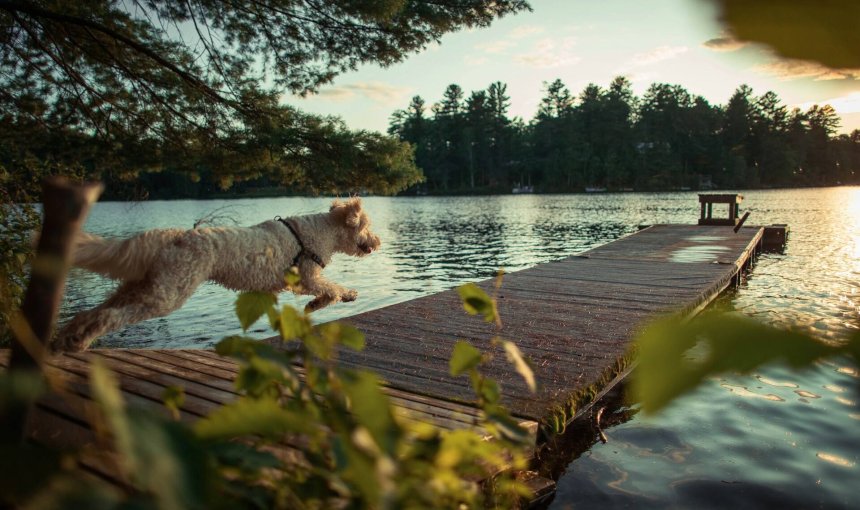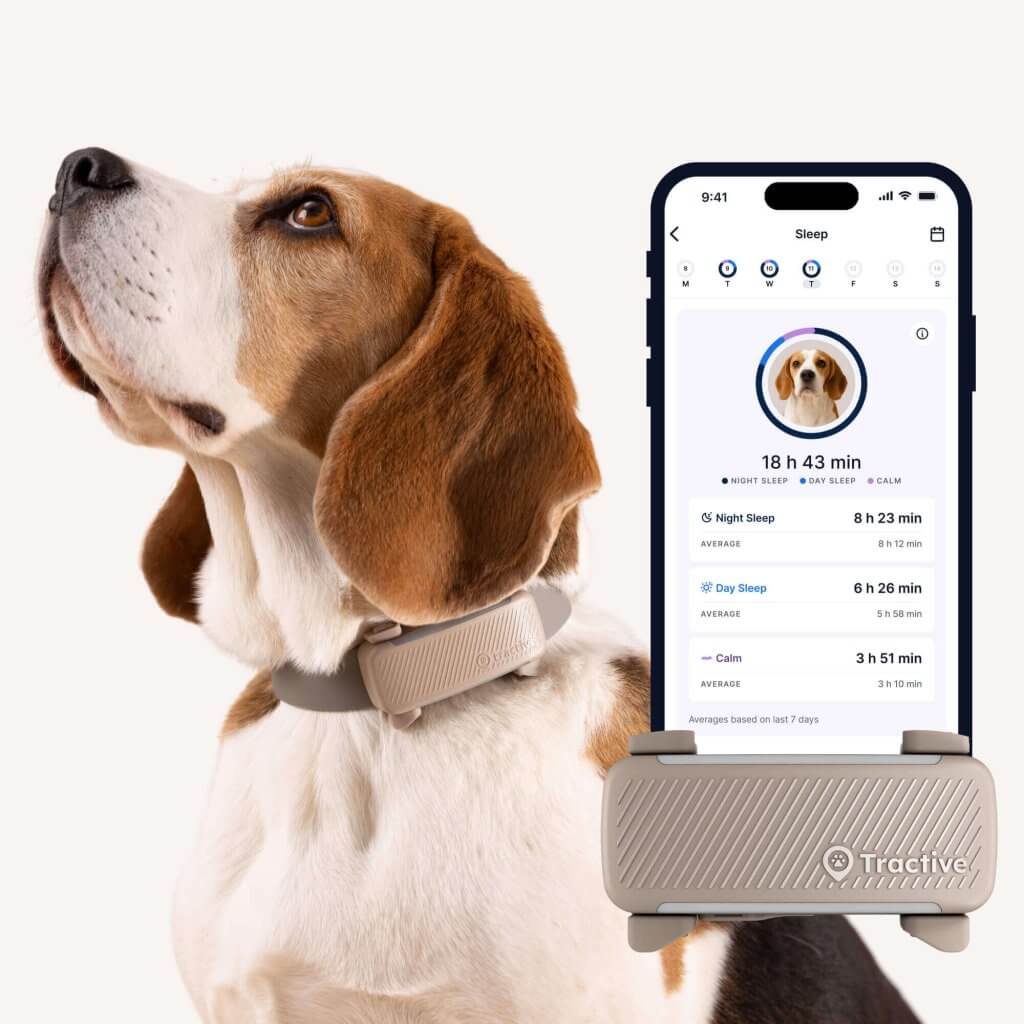 Approved by Dr. Dwight Alleyne, DVM
Approved by Dr. Dwight Alleyne, DVM How Much Exercise Does A Dog Need?
You probably know that physical activity is important for your dog’s health. But how much exercise do dogs need exactly? Turns out, factors like your dog's age, breed, and general health can all play a role.

Exercise is a part of most dogs’ DNA. After all, most of them were bred for activities like herding, retrieving, or patrolling. But no matter if you’ve got a more active dog breed or a more chill, low-maintenance one, you might be wondering: how much exercise does a dog need? Here’s a deep dive into everything you need to know – plus, how to monitor their vital signs, like their breathing and heart rate.
Key Takeaways
🐶 Exercise needs can vary from dog to dog, depending on their breed, age, size, and health.
🥎 A mix of walks, playtime, training, and mental stimulation (like scent games or puzzles) keeps dogs healthy and happy.
⏰ Consistent exercise routines help keep your dog healthy, prevent boredom, and strengthen your bond.
🌎 The Tractive smart dog tracker helps you monitor your dog’s movement and set daily fitness goals based on their needs.

Always know your buddy is healthy & safe
Read moreHow much exercise does a dog need every day – based on age?
A dog’s daily exercise routine can depend on their age and how their energy tends to be around these time periods. Some adult dogs can hike for hours, while puppies might do better with several short play sessions each day. Senior dogs require a more relaxed pace.
How much exercise is enough for a puppy?
Because they’re still growing, puppies need short, frequent walks or play sessions with rest periods in between. (So a long walk around the neighborhood may be too much for them.) A rule of thumb for your puppy is five minutes of exercise, twice a day, for each month of age. So a three-month-old puppy will need about 15 minutes of exercise, twice a day. Puppies become adults around six to 18 months of age, depending on the breed. Large dog breeds take longer to mature.
How much exercise is enough for an adult dog?
Experts say that 30 minutes to two hours of daily exercise is right for most adult dogs. Which might look like a 20-minute walk with your pup each morning and evening. And then a vigorous play session after lunch.
How much exercise is enough for a senior dog?
Senior dogs may have slowed down, but they still need daily exercise to maintain their health – at least 30 minutes a day. If you have a senior dog with painful arthritis, make walks more comfortable by choosing smooth, flat surfaces like sidewalks or paved trails. Avoid steep slopes, which can stress their joints. Finally, consider low impact exercise options like swimming. It works great for dogs with mobility-affecting conditions like hip dysplasia or orthopedic issues, because it is joint-friendly and improves cardiovascular health.
As with any pet exercise program, start by observing your dog carefully to figure out how much exercise they can handle. If you have a senior dog with health issues, it may be wise to talk to your veterinarian before starting a new exercise routine.
How much exercise does a dog need every day – based on breed?
All dog breeds were developed for specific roles – whether that’s being a working dog, hunting dog, or even companion dogs. Some breeds were developed for an active lifestyle – while others do just fine with less exercise. That’s why it’s so important to pick a dog whose daily exercise needs match your lifestyle. If you live in a tiny apartment, a high-energy dog breed may not get enough healthy exercise in your household. You might be better off with a more chill, low maintenance dog breed instead. But if you are an avid runner or have a large working property, a high-energy dog may be a perfect fit.
With all this said – every dog is different. Some might leap at the first opportunity for a walk or run outdoors. Others might be (a lot) more reluctant. So start slow and experiment with what your dog responds best to. Ideally, they should be happily tired at the end of the day.
How can I tell if my dog has gotten enough exercise?
💡A Tractive smart dog tracker can help you set activity goals and monitor how much exercise your dog has gotten all day long. This includes:
- Your dog’s calorie burn,
- How much distance they’ve covered,
- And even your dog’s vital signs – like their breathing rate and heart rate

So at the end of the day, you can check whether your dog could do with an extra walk or two – or some rest.
💡 Setting yourself a daily goal or target for active minutes can also help you stay motivated. With it, you now have an idea of just how much exercise your dog needs to stay healthy.
What are the best ways to exercise your dog?
Whether you live in the city, suburbs, or in a rural area, you’ve got a whole bunch of options to create a healthy exercise routine for your pup.
Outdoor activities
- Hiking & camping
Walking on trails can be physically demanding, plus trails are a scented paradise for your pup’s nose. Just make sure to go well-prepared – with plenty of healthy snacks, a first aid kit, and some prep to ensure you’ve picked a dog-friendly route. - Swimming
Water play is a fun way to cool off on a hot day, and the joint-friendly environment is a bonus for senior dogs. A dog life jacket helps your pooch feel safe and confident in deep water. - Fetching
Running at full speed to retrieve a toy will get your dog’s heart pumping. Just make sure to use pet-safe toys rather than sticks, which can splinter in your dog’s mouth. - Obedience & agility training
Retrieving, weaving, climbing, jumping, and following commands require your dog to focus. - Dog parks & play dates
Your local dog park is an inexpensive way to give your dog access to a large play space and socialize with other dogs. Meet up with other pet parents at a local park for a walk or play session. Another option is a dog daycare with group play, which can also help your dog spend time with other dogs and learn to get along with them. - Dog sports
Like scent work, flyball, herding, and conformation. You and your pup can participate in organized competitions and clubs. Or you can create your own at-home version.
Indoor activities
- Stairs
Run up and down the stairs with your pup a few times. Or toss a ball to the bottom step and ask your dog to retrieve it. Just keep in mind that stairs are more challenging for dogs with short legs, like Dachshunds, Corgis, Bassett hounds. Likewise for brachycephalic dog breeds and puppies of all breeds. - Hide and seek
This simple game provides physical as well as mental stimulation. This activity works best if your dog is skilled at basic commands like Come and Stay. - Obedience training
A few minutes per day of reviewing basic commands like Come, Sit, and Stay require your dog to focus and control their impulses, which is hard work! A well-trained dog is going to be better behaved when you take them outdoors to exercise. - DIY indoor agility course
Use broom handles, boxes, pillows, and hula hoops to create an agility course to fit your indoor space or even your backyard. Else, you could look for a local club that meets indoors.
More tips on how to exercise your dog safely
Besides their age and breed, factors like your dog’s health and general safety can affect the amount of exercise you get them. So make sure to:
- Pay attention to your dog’s signals
Don’t pressure your dog into activities that are too strenuous. Start slow if your dog is not used to being active, and build up gradually over several months. Always carry fresh water for your dog when you are engaging in vigorous activity. And importantly – remember that for most dogs, increased exercise should not require an increase in daily calories. - Keep your vet in the loop
Some pups have health conditions that can affect their ability to exercise. These include arthritis, hip dysplasia, heart conditions, and respiratory issues. Always consult your veterinarian for advice on the best way to introduce new activities to a dog with chronic health conditions. - Stay on top of safety when outdoors
Safety should be at the top of your list when exercising your dog. If you walk your dog after dark, outfit them with a high-visibility or reflective collar. This makes cars and pedestrians aware of your dog’s presence, and will help you locate them if they dash off. - Get your dog microchipped
A microchip works like a permanent ID tag for your dog – and it’ll help a vet or local shelter identify you as the rightful owner in case your dog wanders off and gets lost.

Help your dog stay fit and healthy
Get a complete overview of how much exercise and rest they’re getting. Compare their activity to that of similar dogs. Set daily goals. And find out if something might be off with Health Alerts.
Your furry friend’s health and wellbeing means as much as to us as it does to you. So we’ve made it a priority to only share medically-relevant content on our blog. This post was checked, double-checked, and medically verified by Georgia-based vet, Dr. Dwight Alleyne.

Dr. Dwight Alleyne, DVM
Originally from Long Island, New York, Dr. Alleyne began his career at a no-kill animal shelter before becoming a licensed veterinary technician. He graduated from Cornell University Veterinary College in 2006 and completed an internship at Purdue University. Now practicing in Georgia, Dr. Alleyne specializes in soft tissue surgery and ultrasounds. He also writes pet health articles on his website, “The Animal Doctor Blog” (www.anmldrblog.com).



